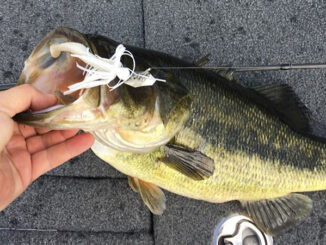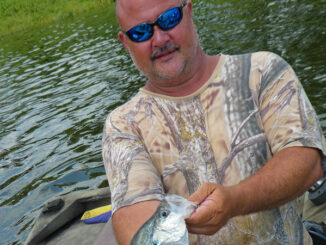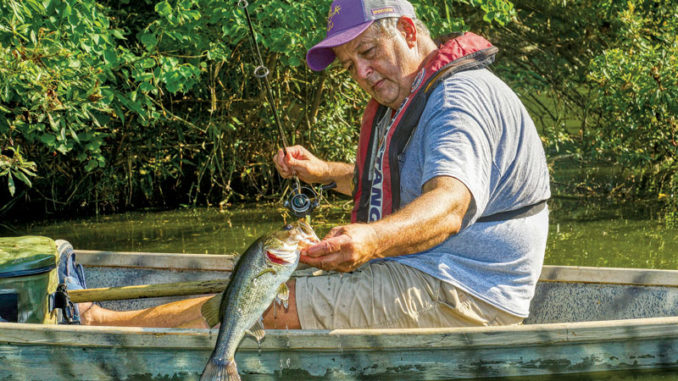
One of the advantages of fishing from a kayak or other paddle craft is the ability to stealthily approach a variety of fishing situations. Sitting low to the water, there is limited shadow cast, and there is the ability to move super-slow with less vibration and pressure sent through the water to spook fish.
On a recent trip to a freshwater lake, Steve Savoye showed a technique he uses to get up close and personal hunting bass in his trusty pirogue. When tree-lined banks make it difficult to make casts without getting hung up in the overhanging tree branches, Savoye uses the pirogue to get just off the shoreline to making casting easy and more precise.
“I can get the pirogue parallel to the bank and easily pitch or sidearm cast right to where the fish are hanging,” he said.
When moving along the bank, he uses a small, hand paddle to move slowly and keep the pirogue in position to drop the cast right where he wants it.
The setup
The key technique he uses is casting unweighted, jerk shad-style baits rigged weedlessly, using a large, extra-wide gap swimbait hook.
“These jerkbaits cast well, even with no weight and have tons of action. On a 5-inch tail, I use a 5/0 EWG hook with the little corkscrew spring that screws the hook into the nose of the bait,” he said. “The big hook allows enough room for the bait to slide out of the way for a solid hookset.”
His preferred setup for this type of fishing is a small spinning reel with braided line.
“The braided line floats and makes it easier to watch the line to detect the quick strikes that happen with these shorts casts,” he said. “I prefer high-visibility colors like white or yellow.”
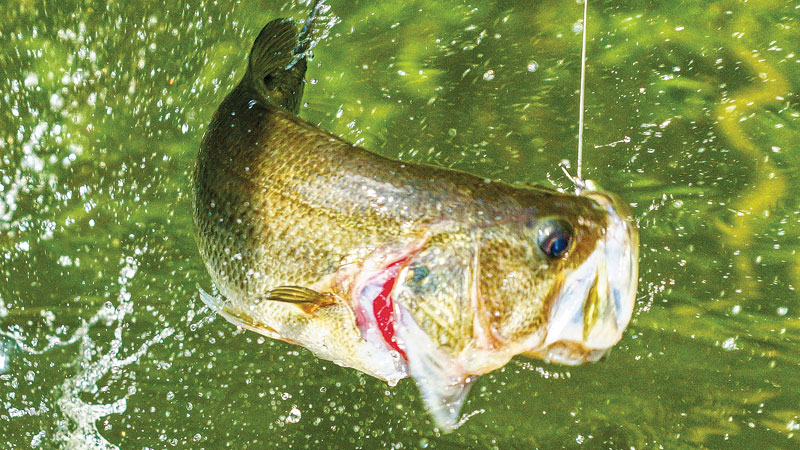
If the banks are relatively clear of logs and stick-ups, tying the braid directly to the hook provides the best sensitivity and no-stretch hooksets. If abrasion is a concern, a 1-foot section of fluorocarbon leader is recommended. Keep the drag tight to avoid it giving line when setting the hook.
Oftentimes, the fish are holding close to the bank where there is some shade provided by overhead trees or submerged fallen branches. These baits can easily be worked through submerged logs and sticks due to the hook not being fully exposed.
The technique
Moving slowly down a bank about 10 yards from shore, Savoye tosses the bait as close as he can to the water’s edge. Often, the strike occurs before the bail can be closed.
“You have to watch the line on each cast. They often pick up the bait while there is still slack from the cast. If you keep your eye on the line, you’ll see it moving and can take up the slack and quickly set the hook all in one motion,” he said.
To get the fish to hold onto the bait those few extra seconds necessary for a solid hook-up, Savoye prefers using scented/flavored baits like Gulp! or others impregnated with some type of attractant.
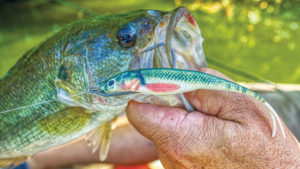
“You need the fish to keep the bait in their mouth long enough to get the slack out and hammer the hook home,” he said.
The action comes quickly. On a recent trip, several bass were caught, all within a split second of the bait hitting the water. The strong, large hooks come in handy when the fight begins mere yards from the boat. The close quarters and tight drags make it difficult to fight the fish for a long time, and they are often at boatside while still quite green. A landing net is much easier than trying to lip a fish that is still full of fight.
Stick around
There is no need to move fast or far. Several fish were caught within a short span, some coming only a few feet from a previous successful cast. If there is no instant strike, short twitches make the unweighted jerkbait dart and dance while slowly moving it back to the boat.
Savoye is convinced that this method is much more successful using a pirogue or kayak than if using a powerboat.
“I can stay much closer to the bank and move at a snail’s pace with no trolling motor noise or water disturbance,” he said. “Plus, sitting so low to the water makes it easy to pitch and skip the bait under the trees and limbs.”

